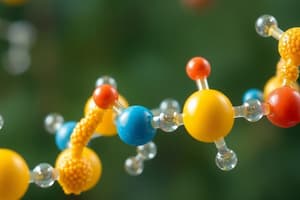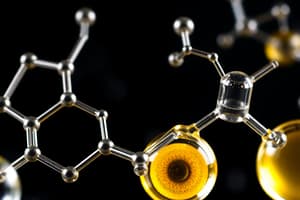Podcast
Questions and Answers
Which of the following elements are most abundant in living organisms?
Which of the following elements are most abundant in living organisms?
- Sodium, Potassium, Calcium, Magnesium
- Carbon, Hydrogen, Oxygen, Nitrogen (correct)
- Iron, Zinc, Copper, Selenium
- Phosphorus, Sulfur, Chlorine, Iodine
Which nutrient type is primarily used to supply the body with energy?
Which nutrient type is primarily used to supply the body with energy?
- Carbohydrates (correct)
- Proteins
- Lipids
- Minerals
What characteristic primarily distinguishes organic from inorganic nutrients?
What characteristic primarily distinguishes organic from inorganic nutrients?
- Their source – whether from plants or animals.
- Their function – providing energy or building tissues.
- The presence of Carbon; derived from living things or not. (correct)
- The quantity needed – large or small amounts daily.
What is the relationship between macronutrients and micronutrients?
What is the relationship between macronutrients and micronutrients?
Given that carbohydrates are composed of Carbon, Hydrogen, and Oxygen, what is their characteristic ratio of Carbon:Hydrogen:Oxygen?
Given that carbohydrates are composed of Carbon, Hydrogen, and Oxygen, what is their characteristic ratio of Carbon:Hydrogen:Oxygen?
What is a peptide bond's primary role in protein structure?
What is a peptide bond's primary role in protein structure?
How does a change in the primary structure affect a protein?
How does a change in the primary structure affect a protein?
What chemical composition distinguishes each of the 20 different amino acids?
What chemical composition distinguishes each of the 20 different amino acids?
Which of these is NOT true of proteins?
Which of these is NOT true of proteins?
What feature of proteins directly leads to their diverse functions?
What feature of proteins directly leads to their diverse functions?
Which level of protein structure is determined by the sequence of amino acids?
Which level of protein structure is determined by the sequence of amino acids?
What types of interactions are primarily responsible for maintaining the secondary structure of proteins?
What types of interactions are primarily responsible for maintaining the secondary structure of proteins?
Which type of interaction is NOT directly involved in determining the tertiary structure of a protein?
Which type of interaction is NOT directly involved in determining the tertiary structure of a protein?
A protein loses its functional 3D shape due to changes in temperature or pH. What is this process called?
A protein loses its functional 3D shape due to changes in temperature or pH. What is this process called?
What structural characteristic is unique to proteins with a quaternary structure?
What structural characteristic is unique to proteins with a quaternary structure?
Flashcards
What is Biology?
What is Biology?
The study of living organisms and their components. It explores everything from the smallest cells to complex ecosystems.
What are Nutrients?
What are Nutrients?
Chemicals essential for maintaining life. They provide energy, building blocks, and regulate processes.
What are Organic Nutrients?
What are Organic Nutrients?
Nutrients containing carbon, usually derived from living things.
What are Inorganic Nutrients?
What are Inorganic Nutrients?
Signup and view all the flashcards
What are Carbohydrates?
What are Carbohydrates?
Signup and view all the flashcards
What is Cellulose?
What is Cellulose?
Signup and view all the flashcards
What are Proteins?
What are Proteins?
Signup and view all the flashcards
What are Amino Acids?
What are Amino Acids?
Signup and view all the flashcards
What is a Peptide Bond?
What is a Peptide Bond?
Signup and view all the flashcards
What is the Primary Structure of a Protein?
What is the Primary Structure of a Protein?
Signup and view all the flashcards
Primary Structure
Primary Structure
Signup and view all the flashcards
Secondary Structure
Secondary Structure
Signup and view all the flashcards
Tertiary Structure
Tertiary Structure
Signup and view all the flashcards
Quaternary Structure
Quaternary Structure
Signup and view all the flashcards
Denaturation
Denaturation
Signup and view all the flashcards
Study Notes
Biology
- Biology is the study of life and living things.
- Key elements for life are Carbon, Hydrogen, Oxygen, and Nitrogen.
- These elements form the basis of proteins, which are crucial for life.
- Biology is also the study of the physical and chemical processes within organisms.
- Life requires a complex array of materials and processes.
Nutrients
- Nutrients are chemicals needed for life.
- Key organic nutrients include carbohydrates, proteins, fats (lipids), vitamins, minerals, and water (H₂O).
- Organic nutrients contain carbon and originate from living things (e.g., rice, bread, vitamins).
- Inorganic nutrients lack carbon and come from non-living sources (e.g., minerals, water).
- Macronutrients are needed in larger amounts daily than micronutrients.
- Examples of macronutrients include: carbohydrates, fats, proteins, and water.
- Examples of micronutrients include: vitamins and minerals.
- Carbohydrates provide energy and are made of carbon, hydrogen, and oxygen (in a ratio of roughly 1 carbon : 2 hydrogens : 1 oxygen).
- Types of carbohydrates include: monosaccharides, disaccharides, and polysaccharides.
- Nutrients are essential for growth, maintenance, and repair of body tissues.
- One of the primary functions of organic molecules, is to provide the structure and function of living things.
- The main building blocks for carbohydrates are monosaccharides, for lipids are fatty acids and glycerol, and for proteins are amino acids.
- Chemical compounds needed for growth, repair and maintenance of living things.
- These include carbohydrates, proteins, fats (lipids), vitamins, minerals and water; both organic and inorganic forms.
Studying That Suits You
Use AI to generate personalized quizzes and flashcards to suit your learning preferences.




